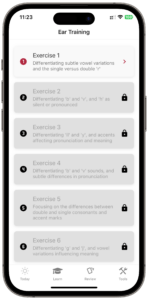Introduction
In this article we are going to explore the crucial role of Spanish minimal pairs in achieving fluency. By understanding and practicing these subtle phonetic distinctions, learners can enhance their listening, pronunciation and comprehension, paving the way to fluency in Spanish.
- What Are Minimal Pairs?
- What are Examples of Minimal Pairs in Spanish?
- The Challenge of Minimal Pairs for Non-Native Speakers
- Significance of Ear Training to Learn Spanish
- Palteca’s Approach: Comprehensive Ear Training Exercises
- The Impact of Mastery Over Spanish Minimal Pairs
- Learn to Hear the Differences in Spanish Minimal Pairs
What Are Minimal Pairs?
Minimal pairs are words that differ by only one phonetic element and can change meanings based on that single sound. In Spanish, mastering minimal pairs such as “pero” (but) and “perro” (dog) is vital as the meaning (often) changes significantly. These distinctions are often a source of difficulty for learners, but they are key to becoming fluent.
What are Examples of Minimal Pairs in Spanish?
Spanish has a lot of minimal pairs. One of the first important ones that new learners encounter are carro (car in many countries) and caro (expensive).
Other examples include:
- casa (house) vs caza (hunting)
- vino (wine) vs vivo (I live)
- jugo (juice in Latin America) vs juro (oath/I swear)
- plato (plate) vs plata (silver/slang for money)
- nada (nothing) vs nata (cream)
- jota (letter J) vs gota (drop)
- mesa (table) vs misa (mass in religious context)
The Challenge of Minimal Pairs for Non-Native Speakers
When we were babies our brains were able to understand every single sound. However, there is a lot of noise in the world, so our brains over time have learned how to ‘tune out’ these noises. Therefore, when we are learning a different language, like Spanish, we have to learn these new sounds. Otherwise, if not, we will never be able to become fluent.
For studies as far back as 1971, we have been studying Japanese people with the English sounds of ‘L’ and ‘R’. Why you may be wondering? Due to there is only one sound in Japanese, while in English, these sounds can be very different (and very important).
The 1971 study showed concluded:
The Japanese subjects were inaccurate in their auditory discrimination between “L” and “R” even when they heard the voices of the Americans. So they were considered to be unable to distinguish “L” and “R” by hearing.
The auditory discrimination of syllables is possible through practice in speech and hearing from early childhood. Without such practice, however, there is considerable difficulty in discriminating them.
Goto, H. (1971). Auditory perception by normal Japanese adults of the sounds “L” and “R.” Neuropsychologia, 9(3), 317–323. https://doi.org/10.1016/0028-3932(71)90027-3
Significance of Ear Training to Learn Spanish
Therefore, science has concluded that you scientifically cannot hear foreign sounds in a different language than your own, once you are past childhood. We’re doomed right? Well, not quite.
In 2002 there was yet another study around /r/ and /l/ in Japanese adults. But what they found in adults was incredible:

Lively, S. E., Logan, J. S., & Pisoni, D. B. (1993). Training Japanese listeners to identify English /r/ and /l/. II: The role of phonetic environment and talker variability in learning new perceptual categories. the Journal of the Acoustical Society of America/the Journal of the Acoustical Society of America, 94(3), 1242–1255. https://doi.org/10.1121/1.408177
After three and six sessions of training, subjects received tests assessing identification and discrimination of /r/–/l/ stimuli as well as generalization. In all cases except fixed training without feedback, subjects showed clear evidence of learning, and several indicators suggested that training affects speech perception, rather than simply auditory processes
Mcclelland, J., Fiez, J., & Mccandliss, B. (2002). Teaching the /r/–/l/ discrimination to Japanese adults: behavioral and neural aspects. Physiology & Behavior, 77(4–5), 657–662. https://doi.org/10.1016/s0031-9384(02)00916-2

Palteca’s Approach: Comprehensive Ear Training Exercises
But what does all of this mean?
Put simply, as adults our brains have learned to tune out ‘noise’. Unfortunately for us, a lot of this ‘noise’ when learning a new language is input that we need to understand to truly become fluent in Spanish (or any other language). However, the good news is, with practice we can rewire our brains to understand minimal pairs and other ‘noise’ that our brain previously was ignoring.
Palteca, the Spanish Learning App, integrates sophisticated ear training exercises designed to fine-tune your auditory skills to help you learn how to distinguish challenging Spanish minimal pairs. These exercises are crafted to gradually adapt the learner’s ear to Spanish phonetics, enabling a deeper understanding and more accurate pronunciation, essential for effective communication.
The Impact of Mastery Over Spanish Minimal Pairs
According to a study in the Journal of Phonetics, learners who underwent intensive phonetic discrimination training showed significant improvement in their ability to understand spoken language and communicate clearly. Mastering minimal pairs in Spanish is not just about listening; it’s about preventing common errors that lead to confusion.
Learn to Hear the Differences in Spanish Minimal Pairs
Elevate your Spanish learning experience with Palteca. Download Palteca, the Best App to Learn Spanish today to start refining your listening skills through our advanced ear training program.

